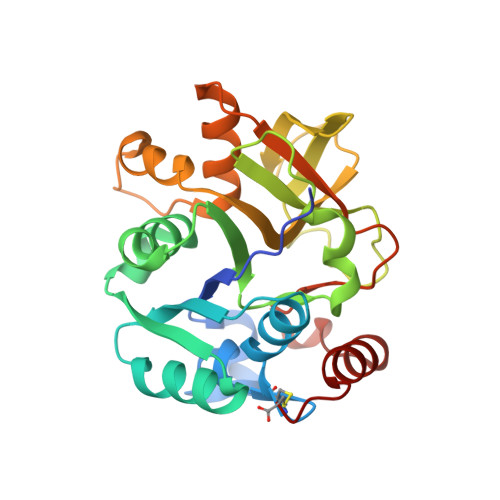Structure of the inositol-1-phosphate cytidylyltransferase from Thermotoga maritima.
Kurnasov, O.V., Luk, H.J., Roberts, M.F., Stec, B.(2013) Acta Crystallogr D Biol Crystallogr 69: 1808-1817
- PubMed: 23999304
- DOI: https://doi.org/10.1107/S0907444913015278
- Primary Citation of Related Structures:
4JD0 - PubMed Abstract:
The unique steps in the synthesis of an unusual osmolyte in hyperthermophiles, di-myo-inositol-1,1'-phosphate (DIP), involve the production of CDP-inositol and its condensation with an inositol-1-phosphate molecule to form phosphorylated DIP. While many organisms fuse both activities into a single enzyme, the two are separate in Thermotoga maritima. The crystal structure of the T. maritima inositol-1-phosphate cytidylyltransferase, which as a soluble protein may transiently associate with its membrane-embedded partner phospho-DIP synthase (P-DIPS), has now been obtained. The structure shows a conserved motif of sugar nucleotide transferases (COG1213) with a structurally reinforced C-terminal Cys bonded to the core of the protein. A bound arsenosugar identifies the location of the active site for inositol 1-phosphate. Based on homologous structures from several species and the identification of the crucial conserved aspartate residue, a catalytic mechanism for this enzyme is proposed as well as a mode for its association with P-DIPS. This structure imposes constraints on the mode of association, communication and temperature activation of two separate enzymes in T. maritima. For the first time, a working model for the membrane-bound P-DIPS unit has been constructed. This sheds light on the functioning of the phosphatidylserine and phosphatidylinositol synthases involved in many physiological processes that are homologous to P-DIPS. This work provides fresh insights into the synthesis of the unusual thermoprotective compound DIP in hyperthermophiles.
- Sanford-Burnham Institute for Medical Research, La Jolla, CA 92037, USA.
Organizational Affiliation:





















